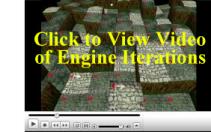
|

Early Development Steps With all of our "grande ideas" on paper, the initial coding steps dealt with two rather mundane (but very important issues): the game's visuals and control method. Wonderland's Visual Make-Over The first goal for the new Wonderland game was to re-design the graphics engine from scratch. The classic Wonderland trilogy used a fairly basic tile system - all straight edges and flat surfaces - but its strength was that levels could be procedurally generated. This meant that levels could be defined simply by stating where walls, water, etc. should go, and the graphics engine would take that simple information and create the entire level model from scratch (without the need to, for example, create each level using complex 3D modelling software).  Hence we wanted to keep the capacity to create levels procedurally, but add complexity to the tile generation system. Through a series of iterative steps, we added the ability to have round corners, smooth height changes, and more. Other basic visual tidbits included a better particle system (to create smoke, fire, and more), a more complex level texture system, and improvements in character animation controls. Many of the changes were subtle. The end result, however, allowed us to provide a far richer visual world for Wonderland players.
Hence we wanted to keep the capacity to create levels procedurally, but add complexity to the tile generation system. Through a series of iterative steps, we added the ability to have round corners, smooth height changes, and more. Other basic visual tidbits included a better particle system (to create smoke, fire, and more), a more complex level texture system, and improvements in character animation controls. Many of the changes were subtle. The end result, however, allowed us to provide a far richer visual world for Wonderland players.

Stinkers and Wee Stinkers With the basic visual engine established, the next task was to explore options for the game's control scheme. As mentioned, one of the earliest decisions was to have the game completely mouse controlled (unlike the classic Wonderland games, which were keyboard driven). We knew that finding a good control method would be essential to making the game fun. We also knew that the 'Wee Stinkers' (who were first introduced in Wonderland Secret Worlds) would play a greater role in Wonderland Adventures, hence basic player control mechanisms were tested hand-in-hand with various Wee Stinker behaviour algorithms. It was fealt that getting one core gameplay element 'just right' would provide a solid foundation to build upon.  At this point the direction of the game took several sudden turns as different Wee Stinker behaviours were programmed and tested. At one point, the game resembled a 'Lemmings'-style game, with groups of Wee Stinkers marching along paths and requiring direction. Then a physics based 'crowd control' algorithm gave the game a 'Pikmin'-like feeling. Finally, a basic mouse control movement for the player combined with a path-finding algorithm for the Wee Stinkers put the game on the right track.
At this point the direction of the game took several sudden turns as different Wee Stinker behaviours were programmed and tested. At one point, the game resembled a 'Lemmings'-style game, with groups of Wee Stinkers marching along paths and requiring direction. Then a physics based 'crowd control' algorithm gave the game a 'Pikmin'-like feeling. Finally, a basic mouse control movement for the player combined with a path-finding algorithm for the Wee Stinkers put the game on the right track.
In fact, after these initial stumbles with the game's control method, Wonderland Adventures looked to be off and running, and we 'celebrated' by officially announcing this work-in-progress game in the Midnight Post (February 2006 Issue). In the next Issue: The story of Wonderland Adventures continues, but its development heads towards a bit of a rocky patch. Can a game suffer from an identity crisis? You'll be able to play an early build of the game and see for yourself how tiny program changes can create a drastically different game experience! 
|
